DEWA’s background history
The Dubai Electricity and Water Authority (DEWA) got established on January 1, 1992 (DEWA Homepage, 2011). This was after His Highness President Sheikh bin Rashid issued a decree that called for a merger between the then Dubai Water Department and the Dubai Electricity Company. The two entities had previously worked on independent basis with the main objective of availing adequate and reliable water and electricity to the citizens of Dubai.
In its efforts to meet the ever increasing demands for its important services, DEWA has kept on rebranding. As such, its recent logo has been uniquely designed to incorporate 3 circles that symbolize the harmonious relationships that the authority strives to cultivate between the environment and the power.
Figure 1 showing the 3 cycles that symbolize DEWA’s rebranded logo

DEWA’s Vision, Motto, Mission, and Values
To ensure that the authority maintains its competitive advantage, the management has established a 5 year strategic plan that spans from the year 2011 to 2015. This plan was structured to include the vision, motto, values and mission aspects. These aspects give rise to additional four themes herein referred to a balanced scorecard. These four themes of the balanced scorecard include the internal and financial processes, learning and growth, customers and the support. Figure 2 is a pictorial representation of how DEWA’S mission and value-based strategy aims to drive the additionally highlighted 4 perspectives.
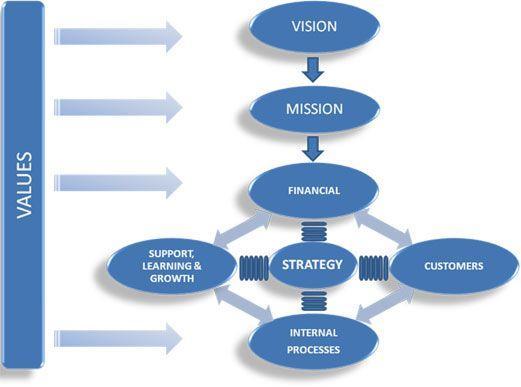
DEWA’s vision is to be recognized as a world-class utility. Its mission is to meet customer satisfaction by delivering water and electricity services. This is to be achieved at a world-class level of efficiency, reliability and safety environment. DEWA’S motto states that the authority is committed to sustain a long-time future that delivers water and electricity to the Dubai population. This is to be achieved by observing sustainable and ethical attitude to the development of water and electricity.
The authority’s values are derived from its mission statement. Following this, they encompass fairness, integrity, teamwork, industry leadership, corporate social responsibility, transparency and customer focus.
DEWA’s workforce and stakeholder identification
According to the latest statistics on the authority’s website, the total number of employees stands at 7696 (DEWA Homepage, 2011). This expanding workforce is led by the Managing Director who also tops up as the CEO. The remaining employees are spread in a 12-level organizational structure as depicted in the succeeding figure 3.
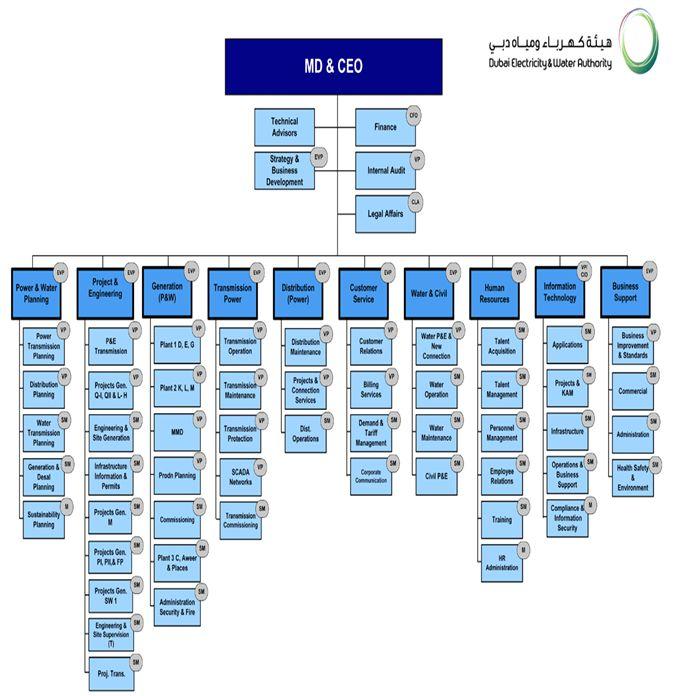
DEWA’s key stakeholders are grouped into 5 main categories namely the government, employees, customers, society/community and its partners. These were further sub-divided as evidenced in figure 4.
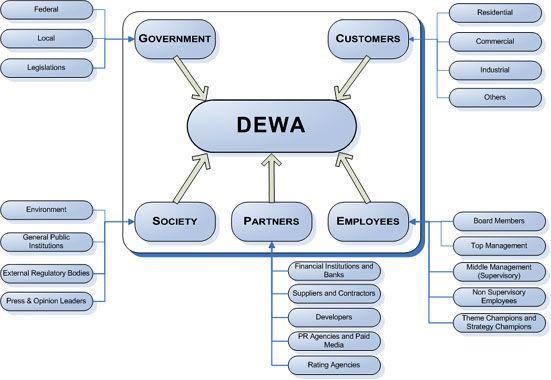
Areas or activities for improvement
Despite the management of the authority insisting on its website that the authority has presented an inspiring success story since its merger, the essay paper established that this was not achieved on a silver platter. This was and is still the case because a number of inefficiencies and challenges did and continue to exist within its operational facets. This essay documented the following background information that presented the activities and areas for improvement.
In the article that explored on the concerns of real-estate developers in Dubai, Safura (2007) averred that the UAE government (represented by DEWA) “was playing catch-up” in providing water and power supply to the hyperactive Dubai’s real-estate and commercial sectors. This was so because, in this essay paper, the authors established that Dubai was well branded based on its often-stated desire of aiming for the best, biggest and fascinating historical projects.
For instance, the world’s tallest building (Burj Dubai) and the world’s largest airport (Maktoum International) presented good examples of the fascinating projects in the city. These 2 have called for great demand for DEWA’s water and electricity services. Notably, the authors point out that the demand of the two valuable commodities had kept on rising at an astonishing rate (of 12-18% per annum) in the whole city. Moreover, a market research report found out that DEWA continued to experience a serious challenge of desalinating the available water to meet the needs of the rapidly increasing Dubai population.
To add, a recent leaked cable authored by the Dubai Consulate (2011) provided a detailed summary of the activities, areas or challenges that faced DEWA to date. These were:
The inadequate feedstock (read gas) that is needed in the production of power. To make matters worse, the report documented that the prices of this inadequate commodity had continued to rise with the current economic inflation. This had made it difficult for the DEWA management to meet their purchase prizes considering that the authority had in recent times been characterized with declining profit trend. A solution for improvement will therefore be proposed in this essay in the succeeding section by use of the PCDA approach.
Other than the above highlighted challenges, DEWA, just like most public utilities entities in the 21st century, has experienced evolution that has in turn led to existence of a variety of challenges. These arose in the course of DEWA employees executing utility management services such as information services, human resource services, 5 year strategic planning and other leadership tasks.
To explore on this, the paper established that for instance, issues relating to wrong water and electricity billing, instances of delayed connections, poor employee relations just to name a few had become the epitome of DEWA’s way of operations (International Labour Organization, 2003). Though these inefficiencies had occurred in piecemeal and little instances, the authors postulated that they stood to have adverse effects on the reputation and general performance of this important authority if corrective measures were not put in place and implemented.
Explanation of our approach
Before going ahead to highlight the similarities and differences between our proposed and case study approaches, the authors saw it necessary to brief reflect on the two case studies of interest. To start with, the authors point out that Tang’s (2008) case study purpose was limited to the design and implementation of an Information Security Management System (ISMS). This security management system was to be utilized by a Taiwan-based telecommunication marketing company in managing its increased security risks. These risks had increased as a result of the company going hi-tech by embracing e-commerce (Tang, 2008).
Moreover, Tang made use of 2 standard measurement tools namely the Plan, Check, Do, and Act (PDCA) and the ISO/IEC 17799 to ensure that the system met the expected and recommended high quality standards. The designed frameworks based on the above 2 tools depicted requisite information security requirements as well their probable impacts on the business of firm Y. In the end of the design process, an efficient system had been developed and implemented. This led to firm Y being certified by a Taiwan based accreditation agency known as SGS Taiwan.
Figure 5 showing how Tang’s case study implemented its system frameworks based on the PCDA cycle and ISO/IEC 17799 standards.
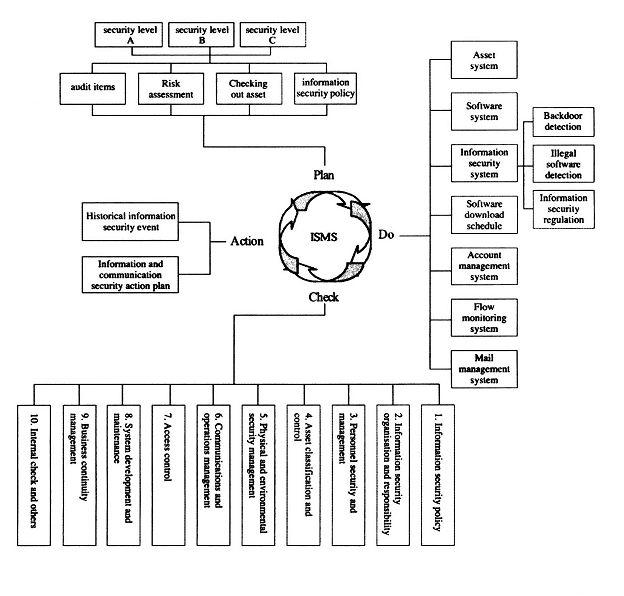
On the other hand, the authors of this essay paper proposed, designed and implemented the following in this case study. This case study involved the selection of a public utility authority in Dubai-DEWA. A background check on the operational activities of this monopolistic authority revealed that the authority had registered success in most of its service delivery functions. Despite this success, a number of challenges and issues related to the management and operation of public utility companies had continued to hamper operations at DEWA.
Various research reports documented a number of these issues and challenges. To help the authors design useful frameworks that can be implemented by the DEWA management to improve on the quality of their services or operations, the authors narrowed down to proposing and designing improvement frameworks for a single activity. As such, this activity will involve the proposal, design and implementation of a fuel diversification program by use of different feed/fuel stocks to improve on the production of sufficient water and electricity.
The justification and the motivation behind the selection of this activity arose from the fact that presently, DEWA has been identifying alternative fuel applications for instance residues from the fossil fuel and coal amongst others to supplement its oil and gas powered water electricity production (AME 2010). This is in order the ever rising demand for these 2 precious basic commodities hence opening a path for a Dubai Emirate characterized by a sustainable future development. The authors will use the PCDA approach to achieve this purpose.
Similarities
Although Deming’s PCDA model was and will be used in the two case studies; the following is a highlight of the main similarities between the earlier case study and this case study with reference to the use of the PCDA model.
First, the author established that the 2 case studies dealt with problems of the same nature (business oriented problems). This was so because company Y had exposed itself to security risks as a result of it embracing electronic commerce. Likewise, DEWA had experienced issues of meeting Dubai’s dynamically increasing electricity and water needs.
Second, the authors concluded a similarity arose in the use of a similar (PDCA) model to address the issues at hand.
Differences
The differences between the two case studies can be explained as follows. To start with, the first difference arises from their conceptual PCDA structures. To expound, the author established that Tang’s case study conceptualized PDCA stages by matching them in the following manner: Plan (establishing the ISMS and the risk assessment), Do (designing ISMS and implementing it), Check (monitoring and reviewing) and lastly Action (Improving ISMS) (See figure 6 below for illustration).
Figure 6 depicting Tang’s conceptual of the PCDA model
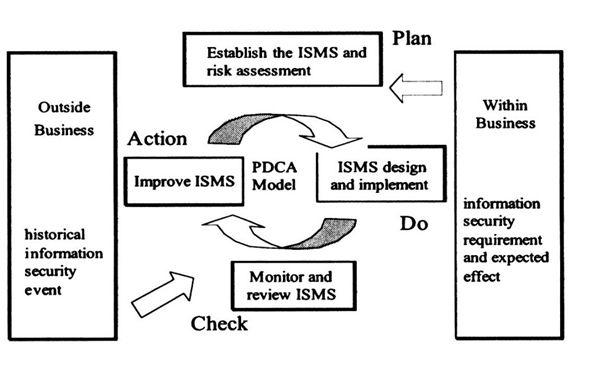
On the hand, the authors of this case study established their unique conceptual structure as follows: Plan (Review DEWA’s current energy practices, assess current risk and establish suitable objectives, policies and procedures), Do (Implement and operate the identified policies and procedures), Check (Audit processes against policies and objectives) and finally Act (Take corrective actions) (See figure 7 below for the pictorial illustration)
Figure 7 illustrating the 5 author’s conceptual view of the PCDA model
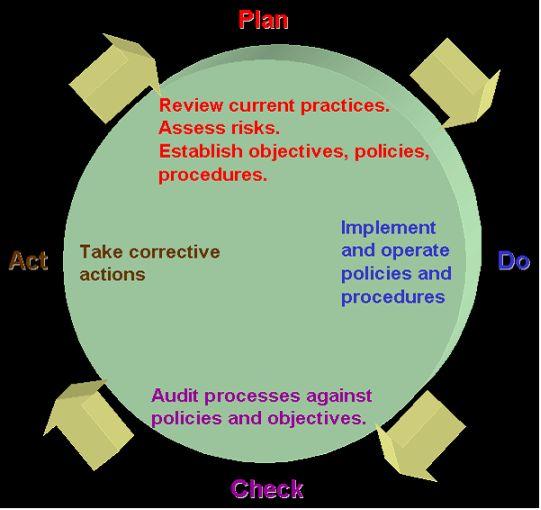
Tellingly, the second difference arises from the themes applicable in the two case studies. Tang’s case study dealt with the designing of frameworks for curb security related challenges. As such, an ISMS was designed and implemented company Y in Taiwan. On the other hand, this case study dealt with the proposal, design and implementation of a fuel diversification program by use of different feed/fuel stocks for DEWA in Dubai, UAE. This was intended to increase the production of electricity and water to meet the rising demand.
The following figure 8 and 9 depict the differing themes.
Figure 8 illustrating the theme in Tang’s case study
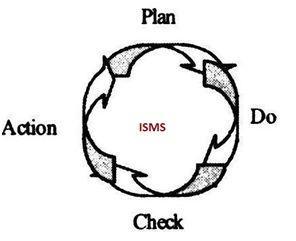
Figure 8 below showing this case study’s theme
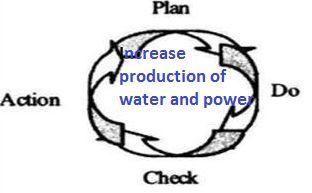
Likewise, an additional difference from the two case studies arises from the fact that Tang’s case study used (ISO/IEC 17799) to derive the best security standards. As such, this ensured that the frameworks in the study’s PDCA model ‘conformed’ to those in the IMIS. In our case study, we aver that the use of the second measurement tool is absent but the researchers of this work have gone extra miles to consult on previous research themes that addressed key and relevant study concepts. This would ensure that the findings discussed in this case study will be of great relevance to DEWA’s management if they adopt or borrow from them to improve on their operational activities as well as to future researchers.
Also, the author’s document that Tang’s case study achieved its specificity at a maximum of a 3-level tier (see figure 9 below) while this case study had a two level tier as its specificity level for most of its designed framworks.
Figure 9 showing a demonstration of the levels
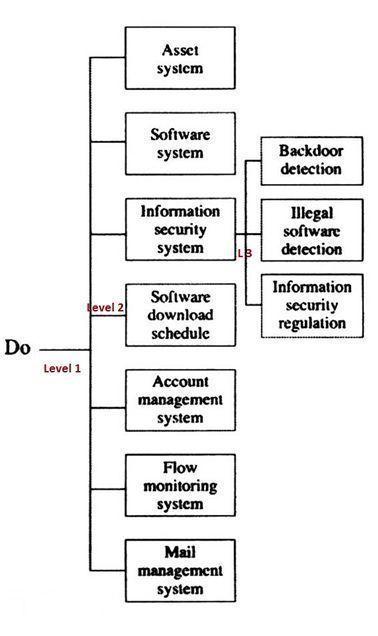
Creating and discussing the schematic structures for the PDCA phases
As previously noted, the authors of this research paper chose to propose and design frameworks of a fuel diversification program that would depend on the use of different feed/fuel stocks. This would ensure that DEWA operates close to its capacity while meeting the highly increasing energy (read electricity in this case) and water resources. To help them achieve this goal, the authors took an approach of using Deming’s iterative model. At this stage, it is worthy to re-state that this important management model has a four step process namely the Plan, Do, Check and finally Action.
To ensure that the proposed and designed feedstock program meets its intended task, the authors decided to adopt a systematic literature review of the key factors to be considered at each of the 4 stages. These factors were then linked to our conceptual design as was previously demonstrated in the figure 7 above. The succeeding paragraphs present these detailed critiques and designs of the schematic diagrams for the proposed program.
The initial design phase
Albeit Deming and some scholars refer to the Plan as the first stage of the Deming model, in this study paper, we stick to the same perspective but go ahead to enrich this notion. As such we assert and recommend that the initial design phase should precede any of the PDCA stages. To defend this notion, we reviewed the most recent and relevant literature of a reputable scholar, Cannon (2011), who postulated that it was necessary to identify the themes or the needs of the activity or the program at hand before going ahead to tackle the policies or procedures in the first stage of the PCDA model. In defending his notion, Cannon (2008) stressed that the data derived from this initial phase was the key in providing the base criteria for refining the subsequent 4 stages of the PDCA.
Still endowed with the findings from the Cannon study, we reveal that our design phase involved the identification of a number of conceptual activities or steps. In line with this, this section was handled as follows: Plan (Review DEWA’s current energy practices, assess current risk and establish suitable objectives, policies and procedures), Do (Implement and operate the identified policies and procedures), Check (Audit processes against policies and objectives) and finally Act (Take corrective actions) (See figure 7 above for the pictorial illustration).
The structure of the plan phase
Ideally, this is what was documented by Deming as the first stage of his iterative management model. A review of the relevant literature on this phase showed that the important aspects that ought to be clearly defined in this phase included amongst others the definition of the problems, and hypothesizing about their possible causes and solutions (Pastinen, 2010).
With respect to the above, we clearly defined DEWA’s problems as arising from a number of hurdles namely the ever increasing demand for electricity and water services by the people of Dubai, and the inadequate feed stocks (raw materials) that are needed in the production of the 2 utilities. In addition, to make matters worse, information from the leaked Dubai Consulate (2011) cable revealed the causes of the problems by documenting that all DEWA’s power plants had continued to run on fuel oil or natural gas feed stocks.
Surprisingly, the overall operating costs for the authority had in recent times been negatively impacted by today’s steep increases in the costs of these feed stocks. These steep increases in costs had not been forwarded or reflected in the bills charged to the consumers of electricity and water in the Dubai Emirate for a long time thus leaving the authority to solely bear all the negative impacts of these results. For instance, we note that the inadequate and high feedstock prices had therefore caused sharp reductions on DEWA’s earnings from almost 40.1% to 10.3% during the one year period ranging between 2005 and 2006.
Having reflected on the problems and their cause effects, we proceeded to propose a number of probable solutions. These include but are not limited to the tripling of the water and electricity generation capacities by the authority. We proposed that over the next ten year period, the production of electricity should be targeted at 21.9
GW while that of water should be set at 1.1 billion gallons. Furthermore, the authors proposed that DEWA should make efforts to expand and upgrade its capacity towards the 2 by carrying out an aggressive capital expansion plans (projected by its management to cost $ 16.3 billion) in its strategic 5 year plan (Dubai Consulate, 2011). These funds can be sourced internally, from the Dubai government or the capital market. Once the funds have been sourced, this essay paper proposes that the authority should sub-contract both local and international firms to enhance water desalination, electricity generation, and construction of water reservoir, pipelines and substations.
The following figure 10 summarized the above proposed activities in this first phase.
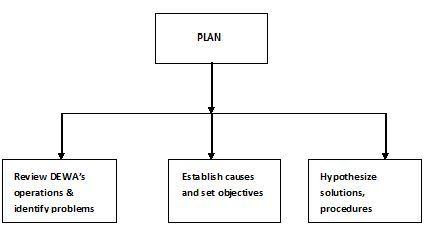
Do phase
In this section, the authors tested the hypotheses of the identified problems. They also went ahead to implement the proposed solutions.
Figure 11 below captured the above scenario.
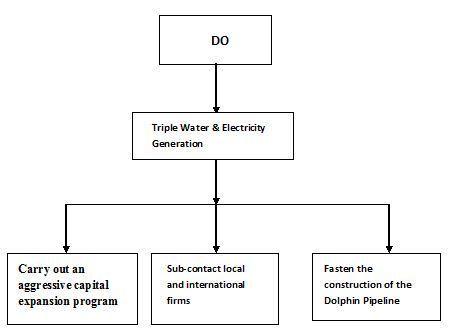
Check phase
The possible or projected results of the test were clearly observed and at the same time evaluated in this phase.
Figure 12 depicting the proposed frameworks in the ‘check’ phase.
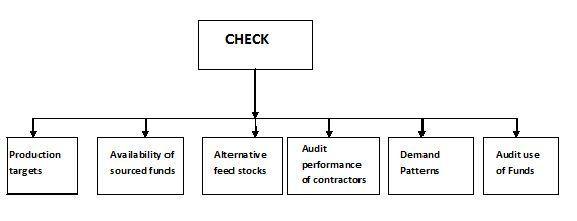
Discussions of the findings of the procedures at this level were documented as follows. During the ‘production targets’ level, the authors stressed that the management team at DEWA should be in a position to study and identify or quantify the differences in the electricity and water levels. For instance, the targeted power output was proposed in this study to stand at 21.9 GW over a ten year period. The management can decide to sub-divide this figure to deriver the yearly statistics of 2.1 GW. The quantities of energy produced from the diversified feed stock applications can then be compared to this target to derive the quantifiable differences.
To ensure that the authority has enough money to fund its activities, the steering team for this diversification program should be in a position to source for the funds from within; the government and the stock or the capital markets agencies. This procedure was captured under the ‘availability of sourced funds’.
The ‘alternative feed stocks’ section refers to the alternative raw materials that can be used to increase the production of both the water and the electricity. A review of the literature on this named coal, fossil fuels, biomass, and wind as some of the alternative applications which can be maximised to supplement the current use of oil and gas as the only sources of power and water production by DEWA (AME, 2010; Dahlgaard et al., 2005).
The audit processes will be used to ensure that the contracted parties are delivering their tasks to the expectant standards. Likewise, the authors propose that the use of the disbursed funds should be monitored by appointing audit firms to curb their miss-use.
Ideally, the study of the ‘demand patterns’ will assist the DEWA management to forecast on the processes that need improvement and then proceed to implement corrective measures in the succeeding stage discussed below.
Action phase
In this fourth stage, the authors of this case study had to borrow the relevant concepts of Dahlgaard (2005) and his friends. As such, we proposed that the steering committee that will be appointed by the DEWA management to oversee the successful implementation of this program should adopt and implement a number of useful activities. These should include and not be limited to communicating the results derived from the previous phase. For instance, what has been the gap in the quantities of water and electricity produced? More so, of great relevancy, the steering team should ensure that the communicated messages are accepted by all parties or project stakeholders to ensure the attainment of the program’s vision.
If unsatisfactory results were received, corrective measures or adjustments should be advanced by the steering committee members. For instance, the team should consider recycling the feedback loop to the Plan or Do phases to establish causes. If satisfactory, standardize and establish them at the Action Phase. This phase recycles by reviewing the whole procedures and suggesting on the areas for improvement.
Figure 13 showing the proposed frameworks in the action phase
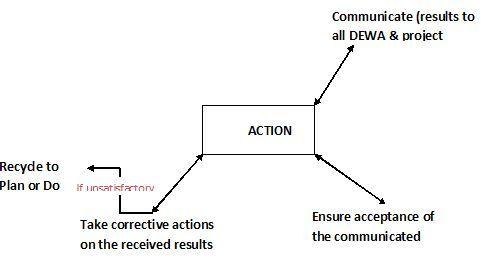
Program frameworks
The following is a harmonized framework for the discussed PDCA cycle.
Figure 14 showing the final harmonized structures of DEWA’s proposed program

Summary of the key learning
While undertaking this case study assignment, the group of authors participated in a number of learning situations which they briefly reflected on. To begin, they asserted that Deming’s PDCA principles and guidelines are useful in enhancing change and quality improvement in most if not all organizations. This is so because these principles provide both reactive and proactive measures if clearly designed and implemented.
To add, the authors established that though the PDCA cycle was initially developed to include 4 critical phases, this model has been expounded by future scholars. As such, it now incorporates 2 additional and important stages namely the design and implementation stages. These stages are also important in ensuring the successful attainment of any PDCA goal. Furthermore, the authors postulate that it is of great significance if the implementation stage is carried out on its own PDCA in such a way that it surveys all the steps time and again.
The authors end by also noting that a successful passage to any PDCA cycle should see the management or the program steering team benchmark the designed processes against set targets. If the management fails in this task, then disciplinary measures must be advanced against them. This is so because as the common saying in Japan states, “management’s job is to manage change and if it fails, then we must change the management” (Dahlgaard et al., 2005).
References
AME (2010). DEWA identifies alternative fuel applications in order to cope with growing electricity demand in Dubai.
Cannon, D.L. (2011). CISA certified information systems auditor study guide. 3rd edn. Indiana: John Wiley & Sons.
Dahlgaard, J.J. et al. (2005). Fundamentals of total quality management: process analysis and improvement. 2nd edn. UK: Routledge.
DEWA Homepage (2011). DEWA history.
Dubai Consulate. (2011). Who’s got the juice? Electricity and water limitations. US Embassy diplomatic cables from Wikileaks.
International Labour Organization (2003). Challenges and opportunities facing public utilities: report for discussion at the Tripartite Meeting on Challenges and Opportunities Facing Public Utilities, Geneva, 2003.
Pastinen, M. (2010). High-performance process improvement. London: Springer.
Powell, S.K. (2000). Advanced case management: outcomes and beyond. Baltimore, USA: Lippincott Williams & Wilkins.
Safura, R. (2007). DEWA rejects water shortage concerns. Arabian Business News.
Tang, J. (2008). The implementation of Deming’s system model to improve security management: A case study. International Journal of Management, 25(1), 54-68.